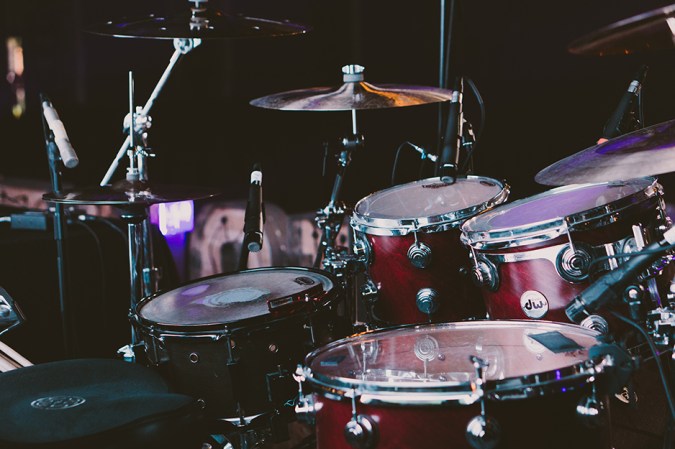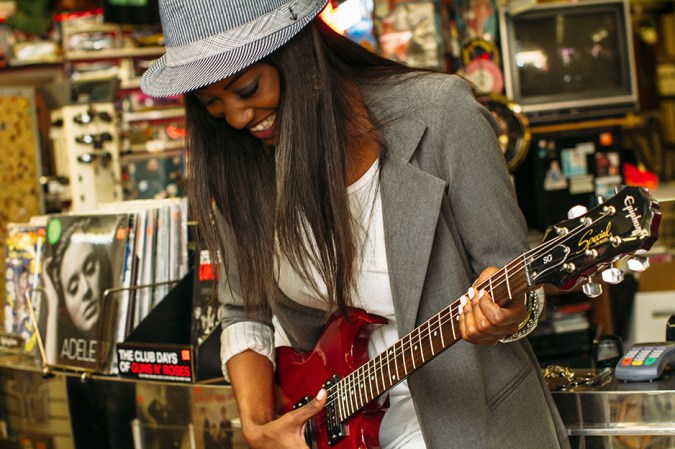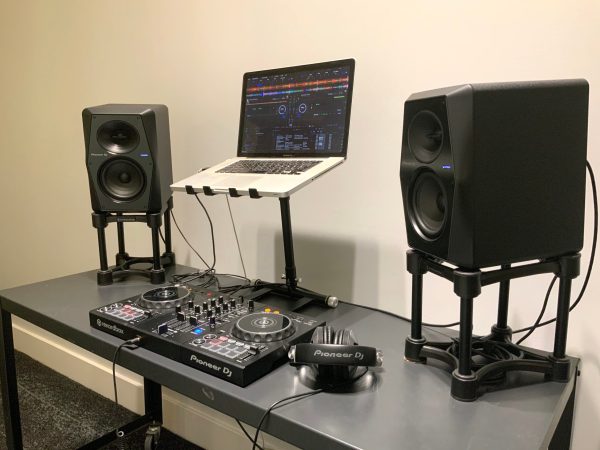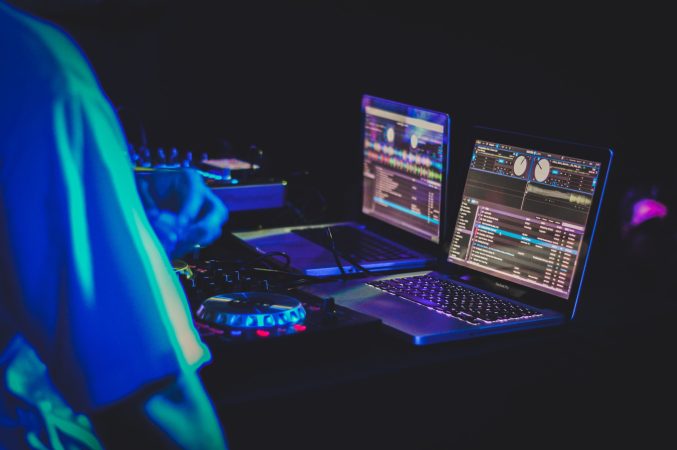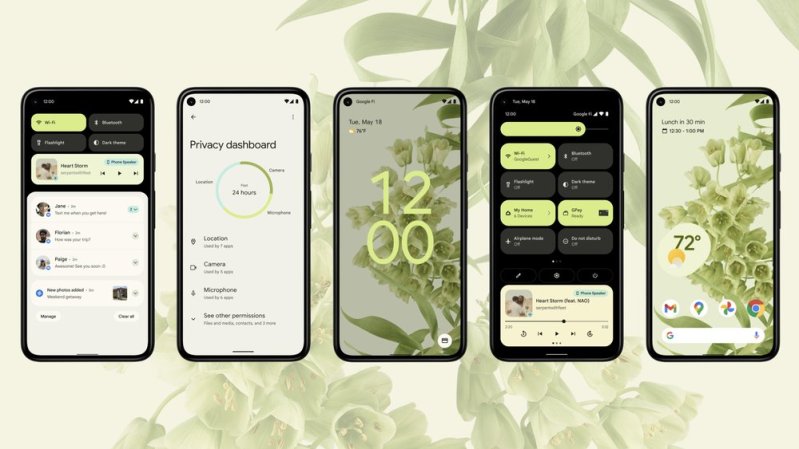

We may earn revenue from the products available on this page and participate in affiliate programs. Learn more ›
The last time you were on Instagram and saw a back-facing photo of a DJ with hands raised in front of an adoring crowd, there’s about an 80-percent chance that the DJ was standing in front of Pioneer DJ gear. Pioneer has dominated club booths and festival stages for decades, in part because the company’s Rekordbox software lets DJs prepare and save tracks and playlists to USB flash drives that plug into their now-ubiquitous multi-players, like the CDJ-3000. That means everything a minimalist DJ needs for gigs—a couple of drives and some in-ear monitors—could fit inside a shirt pocket. However, two CDJ-3000s and a 4-channel DJM-900NXS2 mixer cost over $7,000, so unless you’re already a handsomely paid DJ, it’s hard to work with top-of-the-line Pioneer DJ gear if you also want to eat at least one meal a day. That’s where the Pioneer DJ XDJ-RX3 system comes in: to narrow the privilege gap.
Since 2015, Pioneer DJ has made XDJ-RX all-in-one DJ systems for DJs who don’t need the complete features of two CDJ-3000s and a DJM-900NXS2 but do need to keep $5,000 in their pockets. These $2,000 2-channel performance systems can operate on their own with Rekordbox-prepared USB sticks or as DJ controllers for Rekordbox software on a computer. The Pioneer DJ XDJ-RX3 system improves significantly on the XDJ-RX2, but is it finally the no-brainer all-in-one Rekordbox system that DJs desire? Let’s find out as I explore how the XDJ-RX3 has evolved and put it to the real-world test of performing livestreamed sets.
A Standout Standalone
The Pioneer DJ XDJ-RX3’s design
At about 29 inches wide by 19 inches deep by 5 inches tall, and just under 21 pounds, the Pioneer DJ XDJ-RX3 is larger than most 2-channel DJ controllers but much smaller and less expensive than buying three top-shelf Pioneer DJ components separately. It may be stripped down compared to one of Pioneer DJ’s full industry-standard set-ups, but it does borrow features and the overall experience, such as a similar control layout to the CDJ-3000. The XDJ-RX3 features the CDJ-3000’s more responsive jog wheels—complete with adjustable feel (light to heavy) and the on-jog color display, a circular LED screen in the middle of the wheel that shows album artwork, playhead position, and certain other information like the length of active loops. The sumptuous 10.1-inch color touchscreen at the center of operations is basically the same as the CDJ-3000 display and has a higher resolution (1280×800) and a higher frame rate than the XDJ-RX2’s 7-inch display. Alongside the new graphical user interface, the RX3 is also an upgrade on the previous model in terms of tone sculpting thanks to Sound Color and Beat FX that trickle down from the DJM-900NXS2—20 effects in all.
Getting started with the Pioneer DJ XDJ-RX3
The XDJ-RX3 can operate two ways: as a full-fledged controller for Pioneer DJ’s Rekordbox 6 software or as a standalone DJ system playing music off a USB flash drive. The rear USB-B connection lets the XDJ-RX3 connect to both Mac and Windows computers (while the vivid touchscreen helps break your gaze from them). Two top-panel USB-A ports, meanwhile, support MP3, AAC, WAV, AIFF, and FLAC audio files, although Rekordbox software also supports Apple’s lossless ALAC format. Pioneer DJ has also promised a firmware upgrade in early 2022 that will make the XDJ-RX3 compatible as a controller for Serato DJ, making it compatible with more of the best DJ software options on a computer.
I’ve had considerable experience DJing with Rekordbox software on a laptop with controllers such as the Pioneer DJ DDJ-400, and have dabbled with CDJ multi-players and DJM mixers over the years, so the XDJ-RX3 felt familiar but also like an inviting new landscape to explore. For someone who has never DJed without a computer, an intuitive layout and elements like the performance pads ease the transition, while the ample GUI really did allow me to set aside the laptop and zone in on the RX3 while mixing some of my favorite electronic and indie-dance tracks of 2021. But because you need to analyze music in Rekordbox 6 first, I prepared and practiced sets hooked up to a 2017 15-inch MacBook Pro and then ditched the computer to work solely on the XDJ-RX3 with a USB drive. The XDJ-RX3 is a real best-of-both-worlds situation.
Thinking inside the box
While some all-in-one DJ units—such as the closest competitor, the Denon DJ PRIME 2—perform onboard track analysis, the Pioneer DJ XDJ-RX3 does not. You must do the track analysis first in Rekordbox software (available for macOS, Windows, iOS, and Android), which determines the track’s tempo, beat grid, key, and waveform display, as well as enables performance features like quantization for precise timing for beat-synced effects, loops, cue points, etc. The XDJ-RX3 can playback unanalyzed music but with very barebones abilities, which rather defeats the purpose. After analyzing tracks, setting cue and loop points, fixing the beat grid if needed, and creating playlists in Rekordbox, you export your playlists to USB sticks for plugging into the RX3. Once on the RX3, you can create and edit cue points, loops, and the track’s beat grid from the hardware, but you can’t create or edit playlists on the XDJ-RX3.
The XDJ-RX3 is a “Hardware Unlock” device for Rekordbox 6, which basically gives you the features of the $9.99/month Rekordbox Core subscription without the monthly fee. That includes Performance mode—everything you need to mix music without restraints and record your sets to a USB drive without any additional cost. However, upgrading to a $14.99/month Rekordbox Creative subscription adds features such as video support, a sample sequencer, and Cloud Library Sync for keeping any changes you make to your music’s metadata, playlists, etc. synced across all devices. The $29.99/month Rekordbox Professional plan adds unlimited cloud storage through Dropbox for your synced music collection.
Making connections
A professional-grade audio interface onboard the XDJ-RX3 provides 24-bit/44.1kHz audio quality and a 20Hz-20kHz frequency range. Although that doesn’t quite match the 24-bit/96kHz audio resolution of the DJM-900NXS2 mixer, it always sounded crystal clear with the FLAC and uncompressed WAV files I played on it through Pioneer DJ HDJ-X10-K and Yamaha YH-L700A headphones, as well as ADAM Audio T8V and KRK Rokit 6 G3 studio monitors.
A generous complement of audio connections makes the XDJ-RX3 suitable as the centerpiece of a larger DJ rig. Each of the two mixer channels has both Phono and Line stereo inputs for connecting turntables and media players (say, if you do invest in CDJ units). An additional Aux input has both RCA and mini-jack stereo inputs and its own volume control (because who knows what treasures you might still have on DAT, MiniDisc, or even cassette). Two Mic XLR/1/4-inch combo inputs have EQ and level controls. The Master audio output includes both balanced XLR and unbalanced RCA connections, letting you send the main mix to two simultaneous sources, such as powered monitors, an amplifier, a receiver, or another audio mixer. Additionally, the Booth Monitor output (balanced 1/4-inch jacks)—crucial to running DJ gigs without an additional mixer—lets you connect a second set of speakers with their own volume control if your set-up goes beyond mixing privately in headphones.

Key features of the Pioneer DJ XDJ-RX3
As an all-in-one DJ system, the XDJ-RX3 blends a hardware mixing experience with the possibilities of digital manipulation. Even when you’re not tethered to a computer, you have stacked, scrolling waveforms on the display and the creative live remixing capabilities you can trigger with the multimode performance pads. And, like when using Rekordbox on a computer, you have Vinyl mode for starting/stopping/scratching a track with the jog wheel, all the looping features, reverse playback, and Master Tempo—the ability to lock the music’s key so you can speed up and slow down a track without changing its pitch.
Screen test
The Pioneer DJ XDJ-RX3’s standalone functionality depends on its centerpiece full-color touchscreen, and it doesn’t disappoint. Its GUI fits everything you need to see in the main playback view to comfortably mix music without the need for other monitors: horizontally scrolling waveforms, including grid markers and cue point/loop indicators; track info sections with song title, BPM, track time remaining/elapsed; and full song waveforms you can touch to scrub music and jump to any point in the track.
With the on-screen Countdown timer, you can keep track of your remaining/elapsed set time, and the performance pad Status view shows the active pad mode and the values for each pad. This is very helpful so you don’t accidentally hit any of the 16 pads (eight per side) when they’re not set to the mode that you want. Also, the onscreen Beat FX bank lets you save four of the 14 Beat FX to touch-activated slots, and touch-control the effects from the screen.
The display clearly shows the scrolling waveforms in good detail at any of the five levels of waveform zoom you can set from the rotary selector. There are three waveform color modes, including the new 3Band mode, which clearly shows the low-, mid-, and high-frequency ranges of the track and is very effective for quickly assessing the track’s audio character.
Buttons above the screen get you to the other main view: the track Browser. From there you can search music from the USB drives (or Rekordbox on a connected computer) by Artist, Albums, Key, Track, or prepared Playlists (my preferred method). A bank of four presets lets you save any Playlist for fast, one-touch recall. From the Playlist screen, you can load tracks from either on-screen touch buttons or the hardware Load buttons. But the Browser’s coolest feature by far has to be the full graphic waveform thumbnail for each track, which you can touch at any point within the track to preview the audio through headphones without loading the track to a deck. You can even preview parts of a song that’s currently playing, which can really help if you’re unfamiliar with the music and want to hear what’s coming up.
The Browser includes a History tab that stores the contents of your past sets, and the XDJ-RX3 shows 12 tracks at a time in the Browser—up from 8 tracks at a time on the RX2 thanks to the RX3’s larger display. Unfortunately, the Browser does not let you order tracks by BPM, which along with some basic Playlist editing would be a very helpful addition.
Getting the part
The XDJ-RX3’s rubberized, velocity-sensitive performance pads feel very durable and exhibit a rapid, sensitive response. Pad quality varies widely on different DJ gear, but these are of the highest grade. Whether playing off of USB sticks or off a laptop, you can count on these pads to perform faithfully. The pads do things like jump to different cue points within a track (Hot Cue mode), instantly set loops of different lengths (Beat Loop mode), insert live remixing loop effects (Slip Loop mode), and jump playback forward or backward by different intervals (Beat Jump mode). Two new pad modes include Gate Cue, which plays from a cue point until the pad is released, and Release FX, where each pad activates a unique effect like vinyl brakes, vinyl spins, echo, ducking, mute, and a beat build-up.
In addition to the creative possibilities of the pads, audio effects ported over from the professional DJM-900NXS2 mixer are controlled from the large Sound Color knobs (on each of the two mixer channels to dial in one of six options) and the Beat FX strip (with controls for assigning the affected channel, setting the time intervals and the depth of the 14 tempo-synced audio effects). The display also shows the selected effect and timing values for easy reference. I found it fun and sonically rewarding to chain Sound Color and Beat FX together for some really nice results; for example, stacking the Noise or Crush effects with the Flanger or Phaser or combining an escalating Roll effect with the Filter are great combinations for increasing build-up tension.
Independent artists
The design language and trademark quality of Pioneer DJ’s higher-priced components are obvious in the XDJ-RX3’s marquee features, but also in touches as simple as the iconic LED-ringed Play/Pause buttons and the ultra-smooth crossfader with selectable fade curves. Besides just the comfort and confidence that comes from having a sturdy, well-crafted mixing console, there is a quality all its own from knowing that the XDJ-RX3 is based on the most commonly found DJ gear in clubs and other venues. After a couple of weeks of crafting, broadcasting, and capturing sets on the XDJ-RX3 (including a downtempo/ambient/chillout/lounge session and a bass music/dubstep/electro-funk mix you can stream online), I felt more confident of my ability to take USB sticks into a venue and play them on CDJ-3000s (or the equally entrenched CDJ-2000NXS2) than I have from many years of using DJ controllers with the biggest DJ software programs (including Serato DJ, Rekordbox, and Native Instruments Traktor Pro).
While the Pioneer DJ XDJ-RX3 is too big to take to the DJ booth at my regular club night, I very much enjoyed livestreaming with it as a standalone system for the TerraNova DJ collective’s monthly show. The XDJ-RX3 has proven a satisfying training ground for Pioneer DJ’s club gear that costs far less—and takes up less space as well. As such, the XDJ-RX3 is a capable, versatile system for at-home practice or independent gigs, either on its own or with Rekordbox on a computer.

So, who should buy the Pioneer DJ XDJ-RX3?
The Pioneer DJ XDJ-RX3 represents a clear and sizable improvement over its XDJ-RX2 predecessor. Its enhancements simply make it a more impressive system, and only the smaller display and less robust Browser detract from using it solo as opposed to with a computer. That said, it may not be the all-in-one DJ system for everyone. The analogous Denon DJ PRIME 2 has onboard track analysis (which is missing from the XDJ-RX3), as well as Wi-Fi streaming from music services like TIDAL, SoundCloud Go+, and Beatport Link—and all for the lower price of around $1,500. And if all you want is a decent all-in-one DJ system and aren’t thinking about high-end club gear, the more entry-level Numark Mixstream Pro has a touchscreen, onboard track analysis, and Wi-Fi music streaming for around $600.However, the XDJ-RX3 gives you the feel of mixing on the best multi-players with the added features of some of the best Pioneer DJ mixers and controllers. Small businesses like bars and mobile DJ services should consider this DJ equipment as a viable alternative to a full CDJ rig. DJs who already use pro Pioneer DJ gear at gigs should also find it a worthy option for home practice. Likewise, DJs who either want a secondary practice rig or to ease into the Pioneer DJ system—preparing tracks and playlists in Rekordbox, exporting them to USB drives, and using those USB drives to perform on CDJs—can train on the Pioneer DJ XDJ-RX3 system without facing the price tag of a used Prius. It’s the most undeniably fun, relatively affordable gateway into the professional Pioneer DJ universe you’ll find in a single system.


